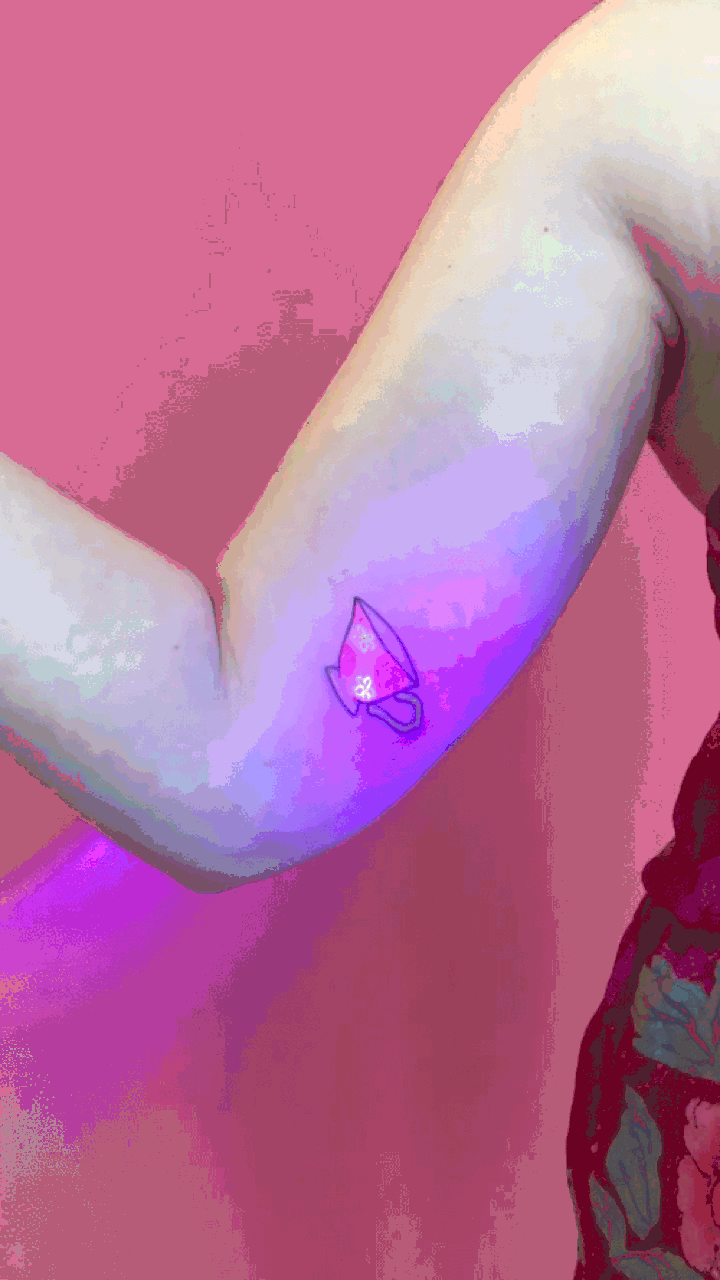Home » Skin & Body Care »
Your Complete Guide to Black Light Tattoos
As Portland-based tattoo artist Kayla Newell set up her station to give me one of her popular glow in the dark tattoos, she asked, "Are you under black lights often?" I took longer to respond than I should have as my answer was a simple no. Most of my time is spent in an artificially lit office or under the warm glow of the single lamp in my room. But I felt embarrassed to admit that. I ended up telling Newell that I'm not typically in black light situations. To my relief, she replied, "That's usually people's answer."
So, why did I get a black light tattoo? Besides having a fun, fluorescent design adorning my skin, getting inked with pigments that glow feels as close as I'll get to a superpower. I have yet to be able to read minds, develop super strength, or teleport. If a black light is somehow involved, I could possibly distract a villainous person with the luminescent flowers on my arm though. Plus, I love anything that could make my skin glow, whether it's a highlighter, vitamin C serum, or a UV tattoo.
What is a black light tattoo?
Yes, black light tattoos indeed glow — but only under black lights. When I turn off the lights at night, my tattoo doesn't glow in the dark like the star stickers you might have put on your ceiling as a kid.
Getting a black light tattoo isn't so different than getting a standard black-and-white or color tattoo. Newell was specific about the order in which she applied the colors, though. "Any amount of darker ink that seeps into the neon can adversely affect the color permanently, particularly its ability to glow when placed under UV light," she explained. So, she started off with the black outline first, then moved onto pink, orange, and, finally, yellow ink.
Are glow in the dark tattoos safe?
Tattoo ink, in general, is not regulated by the Food & Drug Administration. On top of that, glow-in-the-dark pigments used in any cosmetic product is strictly regulated. According to the FDA's website, it has only approved luminescent zinc sulfide is the only luminescent color approved for cosmetic use, and it has limitations for what it can be used in. There are also strict rules for use of neon pigments.
Because the FDA doesn't monitor which tattoo inks shops use, many can still offer true glow in the dark tattoos with ink spiked with phosphorus. However, they can be harmful in the long run. "Phosphorus is a popular ingredient to achieve the glow-in-the-dark effect, and there are some concerns that in high doses it can be carcinogenic," Arash Akhavan, a board-certified dermatologist based in New York City, tells Allure.
Newell avoids inks with phosphorus, though. Instead, she came up with a safer alternative: incredibly bright, highly pigmented ink that happens to be UV reactive. They are naturally fluorescent, 100 percent vegan, and have no added chemicals that cause them to illuminate in the dark. "[Their glow] is entirely coincidental," she says. "The process of making them is the same as any other tattoo ink. They just happen to be naturally fluorescent colors." It's like when you go to laser tag and certain colored clothing or hair colors glow brighter than others. The inks she uses just happen to be like that, too. They're the ones that appear the most neon under black lights.
This is a "safer bet" for a black light tattoo like mine, according to Akhavan. "Although it is possible to have an allergic reaction to the pigments," he says, "the overwhelming majority of patients who have had tattoos throughout history have had no safety issues with traditional tattoo ink."
Is black light tattoo aftercare different than regular tattoos?
The healing process and aftercare advisory are exactly the same as a typical tattoo, too. Newell recommended regularly cleaning the glow in the dark tattoo with unscented soap, letting it air dry, and spreading a thin layer of Aquaphor or a vitamin A and D ointment onto it for about two weeks.

How long do glow in the dark tattoos last?
Like any tattoo, it's "longevity is directly connected to the amount of energy that you put into caring for it properly, like using sunscreen," Newell says. Colored tattoos generally fade over time faster than all-black ones, she adds. They won't completely disappear, though. You'll just need to get touchups when need, which is standard for most tattoos.
What types of glow in the dark tattoo styles work best?
You typically will find black light tattoos in modern styles, like Newell's hand-drawn aesthetic, instead of traditional ones. Newell even told me, "The bulk of the really hateful things people say to me are from other tattooers who work in more traditional styles," she adds. "I think their issues stem from the fact that my style falls outside of any known or acceptable tattoo styles. I don't believe that there are any rules in tattooing but a lot of tattooers do and my style of working goes against many of the acceptable norms and rules."
Tattooing, like any form of art, is not static or standardized. Instagram allows anyone from anywhere to share and celebrate their approach to art. It gives tattoo artists a platform to show the new designs and latest techniques they're trying out. The popularity of watercolor tattoos and stick and pokes have even grown due to Instagram. The same is now happening with glow in the dark tattoos. You're sure to find designs that fit your body art gallery if you do some scrolling through your favorite artists' feeds and hashtags related to black light tattoos.
Source: Read Full Article





